
European
Nuclear Society
e-news
Issue 18 Autumn 2007
http://www.euronuclear.org/e-news/e-news-18/austria.htm


Otmar Promper, Helmuth Böck
Technische Universität Wien
Stadionallee 2, A-1020 Wien, Austria
otmar.promper@gmx.de, boeck@ati.ac.at
One of the biggest challenges in the future of the Austrian power sector is the reduction of greenhouse gas emissions as Austria agreed in Kyoto to reduce greenhouse gas emissions by 13% compared to 1990 levels. Due to increasing electricity demand, there is a need to build new power plants in the future. Today, the use of nuclear power for electricity production in Austria is prohibited by law. The aim of this paper is to analyse the future of the Austrian power sector concerning greenhouse gas emissions and guarantee of supply. Various scenarios taking the above conditions and different technologies into account are calculated. The investigated technologies include fossil fuels, renewables and nuclear power. The aim is to analyse the impact of the different scenarios on greenhouse gas emissions and supply security.
Electricity demand, green house gas emissions, CO2, nuclear energy, fossil fuels, supply security.
In the mid-sixties Austrian energy planning proposed up to five NPPs by end of the 20th century in order to fulfil the country’s electricity demand. The decision in Austria to build the first nuclear power plant (a 723 MWe BWR by AEG/KWU) was taken in 1971 by the Gemeinschaftskernkraftwerk Tullnerfeld GmbH, a state owned power company, The location of the power station was Zwentendorf , 60 km northwest of Vienna, on the river Danube. Construction started in 1972 and it was scheduled to start operation in summer of 1976. After two years of delay in construction the plant was nearly finished in 1978 and was scheduled to start operation in fall. Two years before, in 1976, a very intensive public and political discussion about using nuclear power for electricity production started. Based on this discussion the Austrian government carried out a referendum about using nuclear power. On November the 5th, 1978 the Austrian voted with 50.47% against the use of nuclear power for electricity production in Austria. Since this time the use of nuclear power for electricity production in Austria has been prohibited by law.
Instead of the nuclear power plant two coal fired plants were built. But in the last 25 years many energy aspects changed and today there are totally new challenges in the power sector.
Austria generates most of its electrical energy from hydro power. In 2005 the share of hydro power (river and storage stations) was 57%. 33% were generated from thermal power, 6% from renewables including all bio-energy sources like waste and clearing sludge, 0.2% from others and 4% was from net imports (Fig. 1).
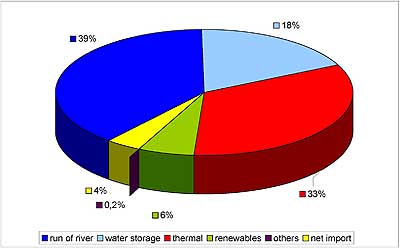
Figure 1: Electricity production in Austria by source 2005
(source: own calculation, [1])
In the early 90s the share of hydro power was nearly 70%. As a reason of this increasing electricity demand, which has increased by more than 2% per year in the last ten years (see fig. 2), the share of hydropower dropped down to 57% and thermal power increased up to 33%. Austria also changed from being a net exporter of electricity to being a net importer since 2001.
Figure 2 shows also three projections of the possible demand for electricity in the next twenty five years. The projection reached from a low scenario with an increase of only 1.5%, a reference scenario with an increase of 2% and a high scenario with an increase of 2.5% per year [2].
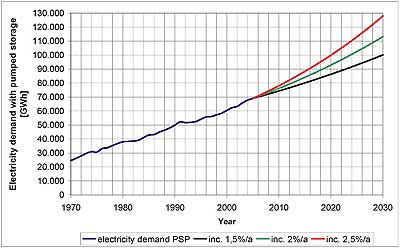
Figure 2: Electricity demand in the past and projection in the future
(source: own calculation, [1])
The potential of hydropower is already used by up to more than 70% and there
is no possibility for a further increase in this sector. To close the gap
between production and demand which will be up to 18,7 TWh in 2021 and 38,6
TWh in 2030, Austria has three options left:
Thermal power with fossil fuels
Increasing electricity import
Nuclear power
Renewable energy sources which are mainly favoured by politicians and media are no option, as their potential in Austria is so small that no major electricity production can be expected except in very local conditions. In adition to wind and solar energy sources reliable back-up energy (either fossil, hydro or nuclear) is necessary to compensate for outage periods.
Increasing the thermal production raises two problems for the power sector.
Austria has only few reserves of fossil fuels. 80% of natural gas and 100% of coal have to be imported.
Increasing thermal electricity production means increasing green house gas emissions
Electricity imports increase strongly Austria’s dependence from abroad. An additional technical problem with the grid and it simply transfers the green house gas emissions problem with abroad
Therefore, the only option is to use nuclear power. Nuclear power can produce the required amount of electricity, has very low green house gas emissions and the fuel amount for several years can be easily stored on site.
The motivation for this paper and is to analyse whether the prohibition of nuclear power for electricity production in Austria is still up to date with respect tp developments since the referendum in 1978. Politicians should not only have their re-election in mind thus following the opinion of the blue-press but they have also the responsibility to ensure a secure and environmental friendly energy policy in future. Therefore, they should initiate a change in nuclear policy to meet the new challenges of the power sector in the future.
To illustrate the impact of different options for future electricity supply on CO2- emissions and supply security of several scenarios were developed and different technologies compared. In this case it is not necessary to calculate the absolute values (of e.g. greenhouse gas emissions) exactly but just to compare two different technologies. Therefore this method is very appropriate for such scenario analyses.
The approach in the models is to build virtual new power plants
with different technologies and primary energy sources over the period of consideration.
The aim of each model is to cover the electricity demand with a range of fluctuation
of ![]() 5%.
5%.
Three scenarios with at least 25 technologies paths were analysed in this work. The period under consideration reaches from 2005 up to 2030. The main scenarios differ in the growing of electricity demand. The details of the analysed scenarios are described below:
Scenario A0 (referenze scenario)/A1
Electricity demand is growing by 2% per year.
Higher utilization of large existing thermal plants then 2005 in A0.
Utilization of large existing plants like 2005 in A1.
Scenario B0/B1
Eelectricity demand in growing by 1.5% per year.
Higher utilization of large existing thermal plants then 2005 in B0.
Utilization of existing plants like 2005 in B1.
Scenario C0/C1
Growing of electricity demand 1.5% per year.
Higher utilization of large existing thermal plants then 2005 in C0.
Shutting down all large existing thermal plants in 2015 before the end of their lifetime.
C11, C12- two scenarios with a lower increase in electricity demand of 1% and 0.5% per year.
The technologies used in the models are listed in Table 1. The primary energy sources in this table are the only realistic ones which can be used in Austria in the future. The efficiency of each technology depends on state-of-the-art at initial construction.
With these technologies the following power plant paths in each scenario were created and analysed.
GTCC with natural gas
CCT plus hard coal (pulverized)
Nuclear power
Nuclear power plus hard coal (pulverized)
GTCC plus Clean coal technology
All technologies, except nuclear power plants, have the same utilization in the model of 6500h per year, while nuclear power plants have a higher utilization of 7500h per year because of their special aptitude for base load.
There are some boundary conditions for the scenario calculations which are valid for all models.
The production of hydropower is constant with 40 TWh per year over the period under consideration.
Renewable energy sources will increase to a share of 10% of electricity production by 2015. From 2015 to 2030 the share of renewables will stay constant between 10% and 12% of total production. Actually this is a very optimistic value [3].
All large (PN > 100MWel) thermal plants will be shut down after a lifetime of 35 years [2].
Considered are only power plants to satisfy the demand without any reserve capacity and given utilization.
All assumptions are conservative. This means e.g. minimal number of power plants, no reserves, best efficiency.
Technology |
Power [MWel] |
Fuel |
Efficiency |
pulvericed coal |
750 |
hard coal |
48%, 50%, 52% |
CCT |
750 |
hard coal |
40%, 45% |
GTCC |
400 |
gas |
60%, 65% |
GTCC |
850 |
gas |
60%, 65% |
LWR |
1200 |
UO2 |
35% |
LWR |
1600 |
UO2 |
35% |
Table 1: Used technologies for new power plants in the models
As it is not possible to show the results of all scenarios and power plant paths within this paper only the most important results, mainly the nuclear scenarios, are presented here.
Figure 3 shows the results of the power generation mix up to 2030 in the nuclear scenario A02 by fuel. The demand including electricity for pump storage will rise from 57584GWh in 2005 up to 92620GWh in 2030. In this scenario there two GTCC plants are considered, which are actually already under construction and operational in 2008 and 2009. In 2018 the first nuclear plant with 1200MWel will start operation and in 2030 three nuclear power plants with at least 3600MWel will be in operation.
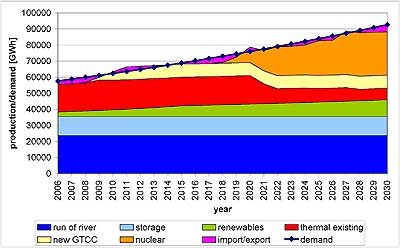
Figure 3: Nuclear scenario A03, increase of demand by 2% per year (source:
own calculation)
The share of nuclear power in electricity production will be 12% in 2020 and 29% in 2030. Hydropower has a share in 2030 of 38%, renewables 11%, existing thermal plants 8%, new GTCC 9% and import 5%.
Figure 4 shows the same picture as in the scenario A03. The main difference is the increasing electricity demand, which is only 1.5% in B03. It starts also from 57584GWh in 2005 and reaches 82316GWh in 2030. As a reason of the lower demand the first nuclear power plant with 1200 MWel start operation not before 2019. In 2030 there are at least two nuclear power plants in operation with together 2400 MWel. The share in electricity production of nuclear power in 2030 will be 21%, hydropower 43%, renewables 11%, existing thermal plants 9%, 10% new GTCC and 6% import.
Compared to the two nuclear scenarios Figure 5 shows the generation mix of the GTCC scenario A01 with an increase of demand of 2% per year.
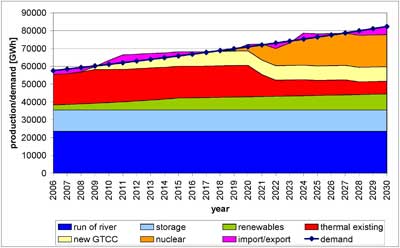
Figure 4: Nuclear scenario B03, increasing of demand 1.5% per year
(source: own calculation)
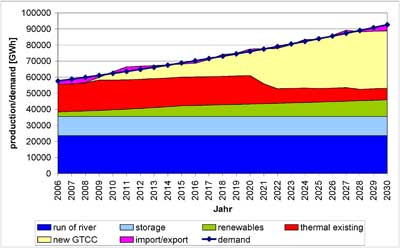
Figure 5: Natural gas scenario A01, increasing of demand 2% per year
(source: own calculation)
In this scenario all new built power plants use GTCC technology. The generation mix in 2030 consists of 39% new GTCC, 38% hydro, 11% renewable, 8% existing thermal plants and 4% import. A big share (47%) of Austria’s electricity production in 2030 will depend on natural gas because all existing thermal plants at this time use also natural gas as a fuel.
In conclusion it can be stated, that Austria’s electricity production in the future will depend more and more on thermal production either with fossil or nuclear fuels. The share of hydropower will decrease in all scenarios from now 57% to below 45%. Even if the increase in demand is reduced down to 1% or even 0.5% the share of hydropower will be 45% until 50% respectively.
New power plant capacity will be required with at least 2400 MWel or even up to 4600 MWel depending on the selected scenario. These are minimum values because of the assumed high utilization factor of new plants in the calculations. Considering reserve capacity and lower utilization the values of the required new capacity will be much higher.
Increasing the production of thermal plants with fossil fuels, means also an increase in fuel demand. As mentioned before Austria has very little reserves on fossil fuels. Only 19.7% of the demand of natural gas is produced in Austria. Most of the natural gas in Austria comes from Russia (58.6%), Germany (12.6%) and from Norway (9.1%) [1]. Also the total demand of hard coal has to be imported, mainly from Poland and Czech Republic (88%). Austria also has no reserves of lignite leel. Moreover, lignite has a very low calorific value and high specific CO2-emission. These are the reasons why lignite has not been taken into account for thermal plants in Austria.
Figure 6 shows the evolution of the natural gas consumption in the reference scenario A0. The values are based on 2005. In the GTCC scenario A01 the increase is as expected very strong. It will nearly triple from 3.6 Gm3 to 9.66 Gm3 per year until 2030. In the scenarios A02 with hard coal and A05 with clean coal technologies, where also GTCC technology is used, the increase is not so strong. In A02 the consumption will nearly double to 6.6 Gm3 and in A05 to 6.27 Gm3. In the nuclear scenarios A03 and A04 the consumption of natural gas will shortly increase until 2011 and then drop back to the values of 2005 until 2030.
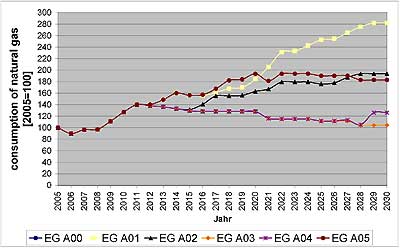
Figure 6: Evolution of the natural gas consumption in Austria up to 2030 (source:
own calculation)
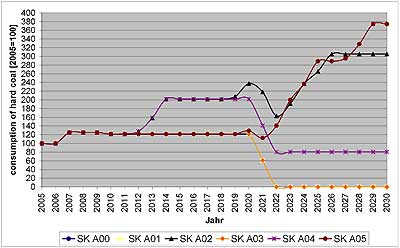
Figure 7: Evolution of the hard coal consumption in Austria up to 2030 (source:
own calculation)
In Figure 7 the consumption of (hard coal) in the reference scenario A0 is
shown. As expected the increase of consumption in the coal scenarios A02
and A05 will be the strongest.
In A05 with clean coal technology the consumption will nearly quadruple, from 1.65 Mt to 6.2 Mt per year in 2030. In A02 it will increase up to 5 Mt in 2030. In the nuclear scenario A03 and in the GTCC scenario A01 the consumption will drop to zero after shutting down the existing plants fired with hard coal in 2021. In the scenario A04 with nuclear power and one new hard coal fired plant the consumption will drop down to 80% of 2005.
The consumption of fossil fuels in the other scenarios (B,C) is equal or slightly lower. It is obvious that more thermal plants (whether natural gas or hard coal fired) will increase the dependence in primary energy supply significantly in the future. The mass flow rates of fossil fuels in the future will, therefore, be very high. This has a negative effect on the security of supply in Austria’s power sector.
For nuclear power plants the consumption is only a few hundred tons of natural uranium per year. Uranium is also a wide spread all over the world and in stable political regions. Thus uranium has two advantages compared to natural gas and hard coal in Austria:
The mass flow rate of uranium is much lower.
The storage possibility of uranium fuel even for several years is very simple and needs little space
Another important point is the evolution of the green house gas emissions in Austria’s power sector. Austria signed the Kyoto Protocol and committe to reducing green house gas emissions (mainly CO2-emissions) to 13% based on 1990 level. The base for the CO2-emissions in 1990 of the power sector is 10.89 Mt and Austria’s commitment is to reduce these emissions to 9.47 Mt until 2012. The share of the power sector of the totally CO2-emissions in Austria is 14%.
Figure 8 shows the evolution of the CO2-emissions in the reference scenario A0. The magenta line is the base of 1990 and the green line the aim of the reduction (9.47Mt). The strongest increase is in the hard coal scenario A02. The emissions in this scenario will more then double from 11.3 Mt in 2005 to 23 Mt in 2030. There is also a strong increase in the GTCC scenario A01. The CO2-emissions in this scenario will increase up to 16.2 Mt in 2030. In the clean coal and nuclear coal scenarios A05 and A04 the emissions will increase until 2021 by up to 13.15 Mt. After shutting down the existing coal fired thermal plants the CO2-emissions will drop down to the level of 1990. Only in the nuclear scenario will the emissions drop down below the level of the Kyoto target. The emissions in this scenario are 6.1 Mt in 2030.
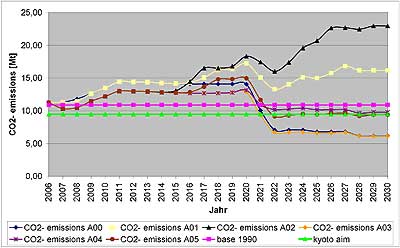
Figure 8: Evolution of the CO2-emissions in Austria up to 2030
(source: own calculation)
The other scenarios show similar values of CO2-emissions. In the scenario B with lower increase in demand the CO2-emissions are also lower, but nevertheless they are above the base of 1990 and the Kyoto target (except nuclear scenario B03/B13). Concluding this section, the CO2-emissions in the power sector will increase in all scenarios except in the nuclear and energy saving scenario.
In summary, the analysis has shown that there is a great requirement for new power plant capacity in the future in Austria, to satisfy increasing electricity demand. Another result of the analysis is that the future of the Austrian power sector leads either to thermal production or to increased imports. Hydropower and renewables have very little potential to satisfy future electricity demand. Direct import of electricity leads straight to dependence on foreign imports for electricity supply, because there is no possibility to store electricity in big quantities.
Concerning the thermal production, the only two options are fossil fuels or nuclear power. As shown above nuclear power can fulfil all the requirements to satisfy the future electricity demand both in view of security of supply and reduction of CO2-emissions.
The need for fossil fuels like natural gas or hard coal will increase in all scenarios (except nuclear) and, therefore, primary energy imports will too. It is difficult and expensive to store natural gas in big quantities. So the excessive increase in gas consumption will also lead in strong dependence of foreign countries and has therefore negative effects on guarantee of supply. Concerning CO2-emissions the nuclear scenarios are the only one which can fulfil the Kyoto aims of Austria. In all fossil scenarios the CO2-emissions will more than double according to the Kyoto aims. There is only one non nuclear scenario which can reach the Kyoto aims if the increase of electricity demand is reduced to about 0.5% per year.
If Austria wants to continue to act as a model state of clean environment in Central Europe it should reverse its anti-nuclear policy to meet the future challenges in the power sector.
[1] E-Control GmbH, www.e-control.at.
[2] G. Brauner, “Entwicklung der österreichischen Erzeugungskapazitäten bis 2015“, Int. Energiewirtschaftliche Tagung IEWT), Vienna 2005.
[3] R. Haas, “Perspektiven der österreichischen Stromversorgung im liberalisierten Strommarkt“, Int. Energiewirtschaftliche Tagung IEWT), Vienna 2005.
[4] S. Böhmer et al., “Stand der Technik bei kalorischen Kraftwerken und Referenzanlagen in Österreich“, Umweltbundesamt, Wien 2003.
[5] K. Kugeler, P. W. Philippen, Energietechnik, Springer, Berlin, 1990.
![]()
© European Nuclear Society, 2007